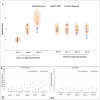G0-PCC-FISH derived multi-parametric biodosimetry methodology for accidental high dose and partial body exposures
- PMID: 38997265
- PMCID: PMC11245508
- DOI: 10.1038/s41598-024-65330-8
G0-PCC-FISH derived multi-parametric biodosimetry methodology for accidental high dose and partial body exposures
Abstract
High dose radiation exposures are rare. However, medical management of such incidents is crucial due to mortality and tissue injury risks. Rapid radiation biodosimetry of high dose accidental exposures is highly challenging, considering that they usually involve non uniform fields leading to partial body exposures. The gold standard, dicentric assay and other conventional methods have limited application in such scenarios. As an alternative, we propose Premature Chromosome Condensation combined with Fluorescent In-situ Hybridization (G0-PCC-FISH) as a promising tool for partial body exposure biodosimetry. In the present study, partial body exposures were simulated ex-vivo by mixing of uniformly exposed blood with unexposed blood in varying proportions. After G0-PCC-FISH, Dolphin's approach with background correction was used to provide partial body exposure dose estimates and these were compared with those obtained from conventional dicentric assay and G0-PCC-Fragment assay (conventional G0-PCC). Dispersion analysis of aberrations from partial body exposures was carried out and compared with that of whole-body exposures. The latter was inferred from a multi-donor, wide dose range calibration curve, a-priori established for whole-body exposures. With the dispersion analysis, novel multi-parametric methodology for discerning the partial body exposure from whole body exposure and accurate dose estimation has been formulated and elucidated with the help of an example. Dose and proportion dependent reduction in sensitivity and dose estimation accuracy was observed for Dicentric assay, but not in the two PCC methods. G0-PCC-FISH was found to be most accurate for the dose estimation. G0-PCC-FISH has potential to overcome the shortcomings of current available methods and can provide rapid, accurate dose estimation of partial body and high dose accidental exposures. Biological dose estimation can be useful to predict progression of disease manifestation and can help in pre-planning of appropriate & timely medical intervention.
Keywords: G0-PCC-FISH; High dose biodosimetry; Partial body exposure; Premature chromosome condensation; Whole chromosome painting.
© 2024. The Author(s).
Conflict of interest statement
The authors declare no competing interests.
Figures







Similar articles
-
Multifaceted applications of pre-mature chromosome condensation in radiation biodosimetry.Int J Radiat Biol. 2020 Oct;96(10):1274-1280. doi: 10.1080/09553002.2020.1798545. Epub 2020 Aug 3. Int J Radiat Biol. 2020. PMID: 32689847
-
Biodosimetry for high dose accidental exposures by drug induced premature chromosome condensation (PCC) assay.Mutat Res. 2010 Jun 17;699(1-2):11-6. doi: 10.1016/j.mrgentox.2010.03.008. Epub 2010 Mar 23. Mutat Res. 2010. PMID: 20338261
-
Use of human lymphocyte G0 PCCs to detect intra- and inter-chromosomal aberrations for early radiation biodosimetry and retrospective assessment of radiation-induced effects.PLoS One. 2019 May 6;14(5):e0216081. doi: 10.1371/journal.pone.0216081. eCollection 2019. PLoS One. 2019. PMID: 31059552 Free PMC article.
-
Current status of biodosimetry based on standard cytogenetic methods.Radiat Environ Biophys. 2010 Nov;49(4):567-81. doi: 10.1007/s00411-010-0311-3. Epub 2010 Jul 9. Radiat Environ Biophys. 2010. PMID: 20617329 Review.
-
Retrospective biodosimetry techniques: Focus on cytogenetics assays for individuals exposed to ionizing radiation.Mutat Res Rev Mutat Res. 2020 Jan-Mar;783:108287. doi: 10.1016/j.mrrev.2019.108287. Epub 2019 Nov 8. Mutat Res Rev Mutat Res. 2020. PMID: 32192645 Review.
References
-
- Johnston, W. R. Database of radiological incidents and related events. Aug. 2019. Accessed: Feb. 20, 2022. [Online]. Available: https://www.johnstonsarchive.net/nuclear/radevents/index.html
-
- IAEA, Cytogenetic Dosimetry: Applications in Preparedness for and Response to Radiation Emergencies. in Emergency Preparedness and Response. Vienna: INTERNATIONAL ATOMIC ENERGY AGENCY, 2011. [Online]. Available: https://www.iaea.org/publications/8735/cytogenetic-dosimetry-application...
MeSH terms
LinkOut - more resources
Full Text Sources
Research Materials

